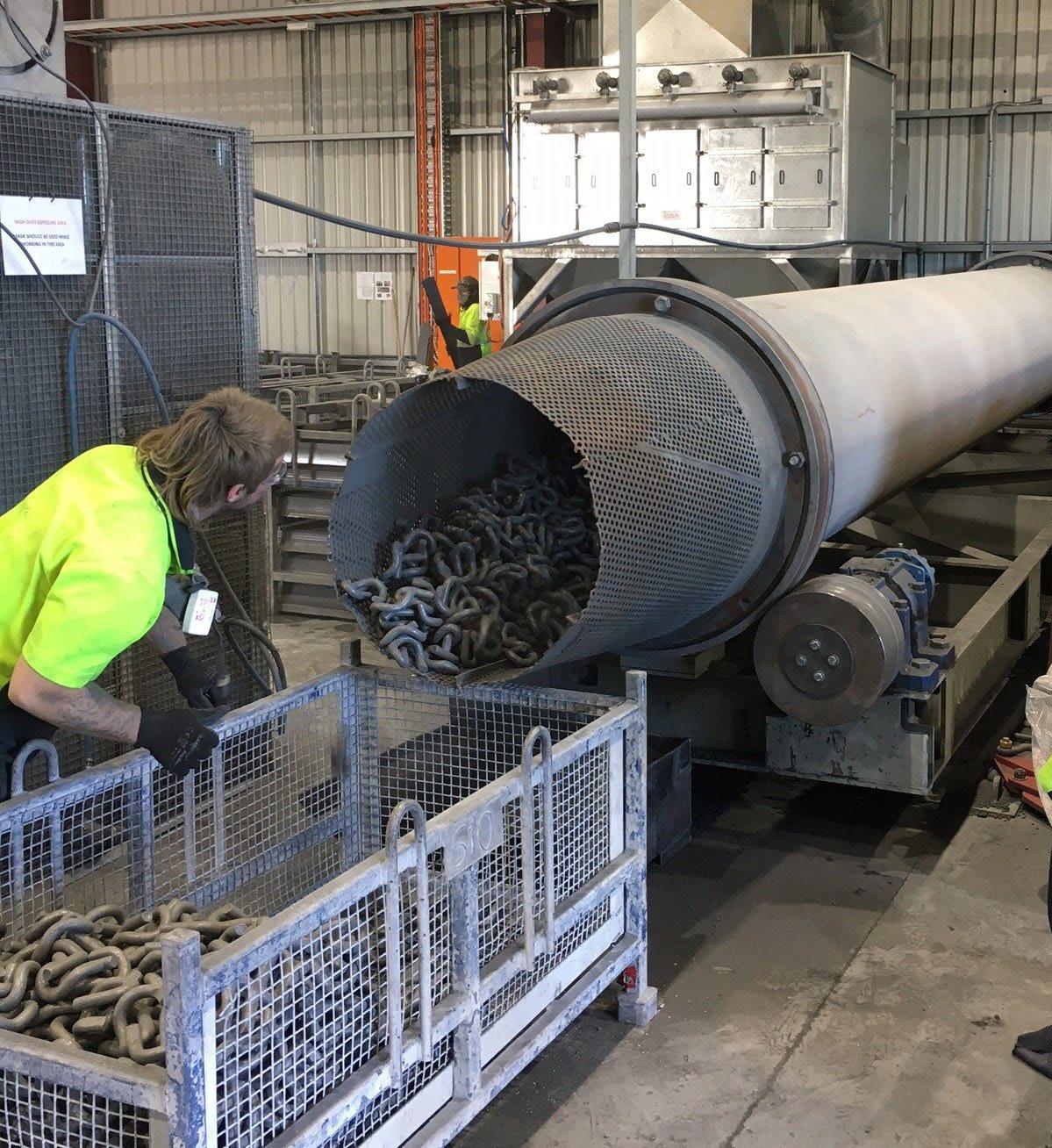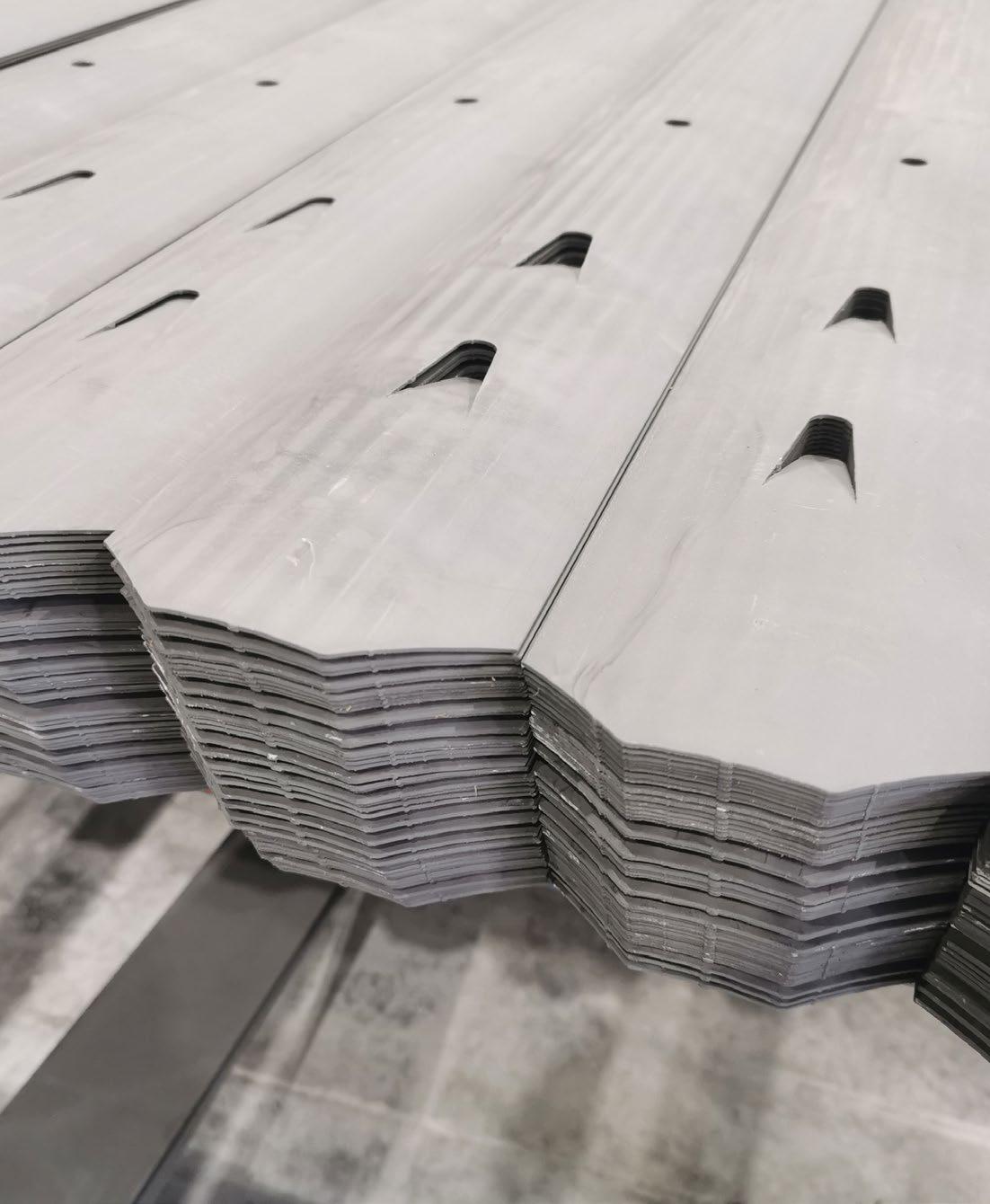
9 minute read
ArmorGalv: Thermal Diffusion Galvanizing

IMAGE: Caption TBC.
Advertisement
BASED JUST OUTSIDE OF NEWCASTLE IN THORNTON, ARMORGALV AUSTRALIA IS THE FIRST PLANT OF ITS KIND IN THIS COUNTRY. THEIR ARMORGALV® COATING TECHNOLOGY IS THE TRADE NAME FOR THERMAL DIFFUSION GALVANIZING. DURING THE PROCESS, A UNIFORM, SACRIFICIAL, ZINC-IRON COATING IS APPLIED TO ANY FERROUS ITEM USING A METALLURGICAL VAPOUR DIFFUSION. ARMORGALV® IS A CORROSION RESISTANT AND ABRASION RESISTANT COATING SOLUTION THAT HELPS INCREASE PART LIFE, EVEN IN THE WORLD’S HARSHEST MINING AND MARINE ENVIRONMENTS.
An English metallurgist named Sherard Cowper-Coles invented thermal diffusion in the early 1900s. He discovered that heating a special blend of dry zinc dust with steel parts in a closed cylinder to at least 343°C resulted in a uniform corrosion-resistant zinc-iron alloy coating. In honour of his discovery, the term for the process became known as ‘Sherardizing’. Difficulties controlling thickness and lengthy processing times saw Sherardizing fall out of favour by the 1950s.
Fast forward 40 years to 1995, and Israeli-based metallurgy company, Distek, discovered and patented modifications to the zinc powder formula that reduced time and improved consistency. That process became known under the trade name ArmorGalv® and is now licensed for use in over 45 sites across Europe, Africa, the United States of America, and Australia.
WHAT IS ARMORGALV®?
ArmorGalv® is the trade name for a thermal diffusion galvanizing technology. It is a method of applying a uniform, sacrificial, zinc-iron alloy coating using a metallurgical vapor diffusion process. ArmorGalv® can be applied on many surface types including powder metal, steel, stainless steel and castings and forgings. Using a thermal diffusion galvanizing process, multiple layers of zinc‐iron alloy are formed, from a super corrosion resistant gamma layer to a compact delta layer and then the zeta layer.
Clive Jones (General Manager, ArmorGalv Australia) said, "Think of an onion, with each layer harder and more corrosion-resistant than the previous one—that's basically what the ArmorGalv® process achieves. ArmorGalv® is tough—it's very hard. This toughness comes from the fact that it is a baking process. The zinc bakes, turns into a vapour, and then bonds onto the metal. The toughness is then locked in, with the component's service life increased by as much as 10 times."
"It's high corrosion and abrasion resistant. It's just about impossible to chip it, or crack it, and its easy to crimp and bend. So, it's great to use on spring steel—it bends, rather than cracking. Threads are a particular area where you really need reliable tension. Anything that is under tension or stress is perfect for the ArmorGalv® process."


by too much heat. With our process, this isn't a factor. So we specialise in high tensile materials. Plus, if you need to apply a top coat, no other preparation is required. It is an excellent substrate for paint, e‐coat and over-moulding with rubber or plastic."
"ArmorGalv® is green, environmentally friendly, totally heavy metal free, and non-toxic. In addition, ArmorGalv Australia recycles as much as we can, and we use solar power. We're doing as much as possible to reduce our environmental footprint."
"ArmorGalv® is very economical for the right product," said Jones.
Thermal diffusion galvanizing is backed by a range of technical standards, including ASTM A1059, ISO 17668, BS EN 13438, ISO 14713-1, ISO 14713-3 and EN 15773.
THE GROWTH OF ARMORGALV AUSTRALIA
As the only company offering the ArmorGalv® process in the country, this industrial galvanizing method is exclusive to ArmorGalv Australia.
"We have been in business for just over 12 years. We started out protecting flexible roadside markers. Our client needed something to protect the markers, and discovered the ArmorGalv® process. We quickly realised that there were many other industries in Australia that could benefit from the use of the process," said Jones.
"Today, we predominantly serve the mining industry, but also the rail industry, the construction industry, civil contracting, and the renewables industry, supplying anchor bolts for wind towers. There are also multiple applications for the process in the marine industry, power lines, solar power, hydrogen, gas, oil and even fastenings. We are constantly growing—we're open to any weird and wonderful project that comes our way," said Jones.
"When we first started out in Australia in 2000, we were located in a small premises, and quickly outgrew it. Our new plant in Thornton has given us a lot more room to grow and enabled us to install bigger, better equipment. Until we moved into our new premises, ArmorGalv® had been Australia's best kept secret—we just didn’t have the room to do any more work than we already had on the books. Today, we've got much more capacity in the workshop."
"We like to think of ourselves as a solution provider. A lot of people don’t know about the process, so we're happy to educate people about how it all works. We’re firmly focused on improving the total lifespan of metals. If we can help materials last longer, this can drastically reduce maintenance costs and the total cost of asset ownership. It is also better for the environment because there is no need to dispose of a product that has gone rusty. The innovative nature of our product is very useful for the future of our industry," said Jones.
THE ARMORGALV® PROCESS
Pre-treatment: Pre-treatment is often unnecessary provided the products are a bright metal. ArmorGalv believes in providing a high quality finish so, where required, degreasing or shot blasting (or both) may be required to remove any contamination or oxidisation that would affect the final outcome.
Diffusion: The products are heated in batches with ArmorGalv's magic mixture and zinc powder in closed rotating drums. The diffusion process starts taking place at 320°C, where the powder gets converted to vapours and form multiple zinc and iron alloy layers. Working temperatures range from 350°C to 450°C, so that high strength steels can be processed at lower temperatures.
Finishing Treatment: Once the container has cooled sufficiently for safe handling, the product is unloaded for finishing. The followup treatment requires a thorough wash to remove excess dust and then ArmorGalv adds a chrome-free passivation and a clear sealer to give a clean and long lasting finish. Where clients require an epoxy top-coat, ArmorGalv must be advised prior so that the sealer is left off.
Packing: Finished goods are packaged for shipment.
CLICK HERE TO LEARN MORE ABOUT ARMORGALV® AND THE
BENEFITS IT HAS TO OFFER >>>
Environmental Sustainability
ArmorGalv® thermal diffusion galvanizing provides important environmental benefits, including: • Low emissions • No chemical pre-treatment • Entirely closed zinc process • No dangerous gases • No chemical waste flows
ArmorGalv® is a completely non-toxic and heavy metal free, environmentally responsible protection against corrosion and wear and tear. Thermal diffusion galvanizing is a cost-effective investment. The long service life has been proven for decades in industrial and marine applications and is testament to its sustainability.
The service life of several zinc coatings in a variety of atmospheric environments is described in EN ISO 14713. The expected service life of a thermal diffusion galvanized coating of, on average, 35 µm is more than twenty years if used in an urban environment. The corrosion resistance can be substantially increased through the application of a thicker coating to over 100 µm or top coating to a diffusion galvanized surface. In salt spray tests, the ArmorGalv® system produces results of more than 2,000 hours.
No Hydrogen Embrittlement
ArmorGalv® products are guaranteed free of hydrogen embrittlement. This is particularly important in the case of safety components and products made from spring steel, hardened or high-strength steel.
Hydrogen embrittlement is caused by the diffusion of atomic hydrogen in the steel. Thermal diffusion galvanizing is a dry galvanizing process, and this means hydrogen embrittlement is technically impossible. The pretreatment means there is no chance of hydrogen embrittlement because it involves blasting. Any hydrogen present in products will disappear during the process of heating to 300°C, before the zinc iron alloy layers are formed.
By comparison, other methods, such as electrolytic and hot-dip galvanizing, involve the products being pretreated by acid dipping. During such a process there is a chance that products will absorb atomic hydrogen.
Temperature Resistant
The stable zinc-iron alloys formed by thermal diffusion galvanizing are diffused 10 micron into the base material and can be used at high temperatures without the zinc diffusing into the steel. This prevents any liquid metal embrittlement. The coating is heat resistant to temperatures more than 600°C. The zinc-iron alloy does not melt but will burn at temperatures of approximately 1,000°C.
Thermal diffusion galvanizing is ideal for ensuring that connecting components in engine rooms and exhaust systems are protected from corrosion at high temperatures. Thermal diffusion galvanized valves and flange connections in the offshore oil and gas industries are used at operating temperatures of more than 400°C.
Tough and Wear Resistant
ArmorGalv® applies a uniform, tough and wear resistant zinc layer, even if the product has a complicated shape. The zinc layer protects against, among other things, damage caused by mechanical stress.
The zinc-iron alloy is metallurgically bound by diffusion into and onto the base material. The hardness of the zinc-iron alloy is approximately 40 to 45 HRC which exceeds the hardness of the steel to be galvanized. This produces an extremely high resistance to wear and tear. Connections for steel and wood constructions, scaffolding and formwork are protected against corrosion and wear and tear, even after frequent assembly and dismantling. Gear wheels, shackles, locking pins and shafts used in machine, bridges and mining engineering are precisely thermal diffusion galvanized and therefore protected in the long term against mechanical stress and corrosion.
Adhesive Surface
The ArmorGalv® surface structure is micro-crystalline and has a natural roughness and unevenness. A surface structure like this is the perfect basis for lubricants, lacquers, coatings, adhesives, and rubber (vulcanisation). This has several benefits.
Lubricants are absorbed by the microcrystalline surface, leading to longterm lubricating properties. Lacquers and coatings acquire special mechanical bonding qualities on an ArmorGalv® surface. Application by spraying, dip spinning, electrostatic or catophoresic processes is possible without pretreatment. Thanks to the bonding surface, adhesive connections form an inseparable, rigid connection. Vulcanisation on ArmorGalv® products can be achieved by applying the binding primer directly to the diffusion galvanized surface.
Uniform Application
Thermal diffusion galvanizing is a dry galvanizing process which involves zinc being vaporised at high temperature and diffusing into steel. The zinc-iron alloy layers formed follow the product contours exactly. The layer thickness can be set precisely to between 20 µm and more than 120 µm.
Strong profiled components, products with an internal thread and the inside of hollow products are galvanized with a coating of the same thickness. Flat products such as rings, discs and sheets are galvanized uniformly irrespective of whether they are thick, thin, or vulnerable parts weighing just a couple of grams or more than 100kg each.











